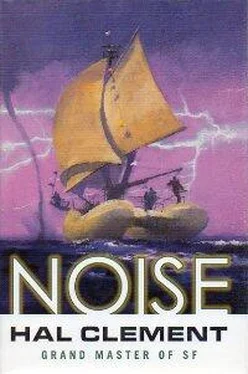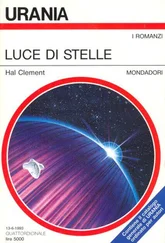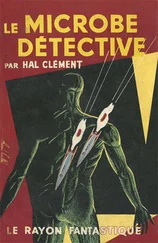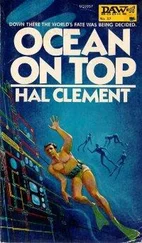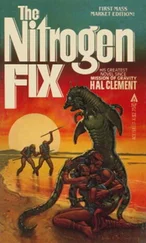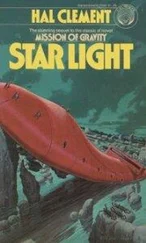When they got back to their starting point there was no sign that the first marker had either risen or fallen significantly. The berg’s water line was not, of course, perfectly definable since the sea was never smooth, but all agreed that no certain change could be seen.
“So far.” ’Ao’s morale was now very high, and she still hoped for points. The captain simply nodded. Mike took a chance.
“If it’s melting at all rapidly, and it does seem to be shedding those spicules all the time, and they’re less dense than water, the whole thing ought to sink a little, rather than rise and tip over,” he remarked.
“How about if they’re less dense than water but denser than ice?” countered ’Ao. Mike started to answer, hesitated, and lost his chance to answer as Wanaka spoke.
“Depending on how fast it’s losing ice as well as coral below. We don’t know how far down the thing goes into saltier water, only that it’s deep enough to have been carried north by deep currents. Right, ’Oloa?”
“No, Captain. In the last two days its northward drift has slowed and stopped. It is now drifting back to the south at about half a meter a second.” Wanaka’s eyebrows rose.
“And there’s no way to tell whether it’s the current that’s changed or the depth of the ice and coral,” ’Ao added at once. “Two unknowns, one datum.”
“Or both,” added Mike.
“And it’s certainly much too deep for us to find out by diving,” Keo put in.
“So we keep sailing around it until the water line changes,” Wanaka stated firmly.
“And if it doesn’t, when do we try something else?” asked the mate.
Wanaka’s rather grim smile could just be made out behind her mask. “Until we get a better idea,” she gestured. “All hands, start thinking.”
Mike’s courage again rose far enough.
“Shouldn’t one or two of us get back ashore and study the structure more carefully while we wait?”
“If we keep circling, those ashore won’t always be in sight from the ship,” returned the captain. “Still—” She thought for several seconds. Then, “Well, if two of you are roped together and you stay well away from the edge, nothing too serious should happen.”
“Mike and me,” cried ’Ao at once. Wanaka shook her head negatively. “If Mike falls, you won’t be much good on the other end of the rope. Sorry. You’ve been growing up nicely and we’re proud of you, but not that way. The shore party will have to be both adults, and I can’t very well leave Mata . That pretty well narrows it down.”
’Ao made one more try. “Keo’s too light to handle Mike, too. It might as well be—” Wanaka shook her head again.
“You’re right in a way, but Keo’s a lot heavier and stronger than you are, dear. You’re thinking yes or no rather than how much. I’m afraid it’s still no, but no one blames you for trying. Also, it looks as though I am going to need ’Oloa here.” The child shrugged and gave up. Mike was tempted to support her request; she would certainly be able to reach places neither he nor Keo could manage. However, the two of them should be able to mark such places and have the lightweight examine them later.
Armor consumables were checked, safety lines examined and attached, Mata stood in as close to the ice as her crew dared, and the men plunged into the sea. They had to swim a hundred meters or more to the right before being able to get ashore; being generally wave-worn didn’t make the rim slope uniform. They picked up a pair of spicules each and dragged themselves out of reach of the waves, made sure of the line connecting their suits, waved to the ship, and started away from the sea. Mata was hove to; the captain felt no particular hurry about the next circumnavigation, both men assumed.
The climbing at this point was much more difficult. The ice slope was shallower, smoother, and generally wet . Waves traveled fifty meters or more up the slope from where they broke. They found it better to crawl most of the time, hitching along by digging a coral spike into the ice ahead of them and pulling themselves toward it. They were over two hundred meters from the sea before reaching humps of any size, and were still scarcely ten meters above Mata ’s deck.
It was easier to go around the humps than over them, however, and this quickly put the men out of sight from below. ’Ao quickly climbed to her masthead station and was in sight for a few more minutes; but finally, after a farewell wave from both parties and a loud-as-possible yell from Mike, all contact was lost. Wanaka, they knew, would not be considering them for the moment; a waterspout was bearing down on the area where the ship had last been visible, as though ordinary noises weren’t interference enough. Thunder remained at standard background level; they were still far below lightning risk as far as either could judge, though the sky flickered as usual.
The general ice slope was getting steeper now, and its imbedded coral spicules regular enough in arrangement to be helpful in travel; in many areas they were projecting slightly above the ice itself. At the steepest places they would almost have formed steps if they had been closer together. It was quite possible to walk most of the time, even for Keo.
All travel was suspended for some minutes when the waterspout actually tried to climb onto the ice—both men looked uneasily for fragments of Mata— and died from lack of feed. The column collapsed over some hundreds of square meters of the berg’s area and washed both men some distance back toward the sea. They were relieved by catching a glimpse of the still floating ship by managing to stop themselves well short of the ocean, and for Mike because the captain was not close enough to comment on a possible reason, other than rising, why the lower parts of the berg had been smoothed as though by wave action.
Distance was too great to tell whether they had been seen from aboard, and it seemed to both the climbers that the best thing to do just now was to continue their exploration. It seemed unlikely that Wanaka would have ordered them back even if they had been in touch; falls had been foreseen and the safety lines had worked, after all.
A little farther up the general slope they discovered a few hailstones in the occasional hollows. They wondered why these had not been visible lower down or during the earlier climb, decided that waterspouts were a plausible answer, that more extreme rise and fall of iceberg or ocean wave might be another, and that the rain that normally accompanied the hail in thunderstorms might well be a third; and Mike filed yet another possible reason for the smoothed-out lower slopes of the berg.
The only problem, he reflected aloud to Keo after making a cautious test around his mask, was the presence of liquid salt water in some of the hollows still holding hailstones. The mate’s experience with frozen puddles on Earth was nonexistent, but even he could see that water produced by melting in the ice hollows should have been fresh, though probably carbonated. For that matter, he added, if the hail-filled hollow they had seen earlier had been exposed to rain as well, it should certainly have looked quite different.
Neither of them had any way of measuring the actual temperature, and neither knew enough to consider the effects of even slightly salty spray. Their ignorance might, just possibly, have been bliss, but made no difference in the long run.
Higher up still, another hail-filled “crater” was found. Very careful checking showed that the hailstones were not cemented together, at least near the surface of the deposit; like those in the other pit, they could easily be removed by the handful.
They ate and slept near what seemed to be the highest area of the berg. The arrangement of the coral here was just as it had been lower down. The region was fairly flat; from its center they couldn’t see ocean. The whole mass was not nearly as high as they had judged from below. Their line of sight would not have reached sea level now less than three kilometers away. Even from the edge of the plateau that formed the top of the berg, where the slope was steeper than any they had faced lower down, the water itself could not be seen; too many humps and bumps intervened. Mata was not in sight, but could easily have been, and probably was, too close to see. The captain’s suspicion that the whole structure had been artificially grown was becoming more and more plausible to Mike, from the way the spicules were arranged. Keo seemed never to have doubted it seriously.
Читать дальше
